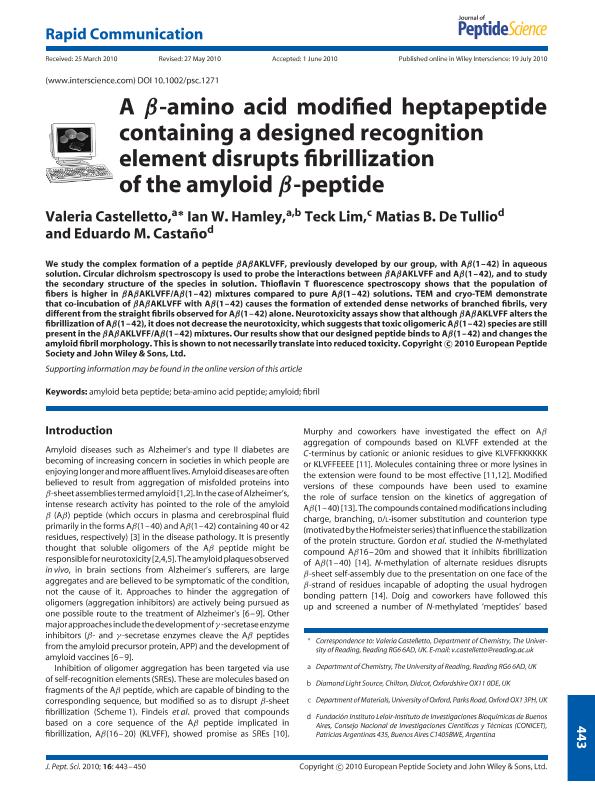Mostrar el registro sencillo del ítem
dc.contributor.author
Castelletto, Valeria
dc.contributor.author
Hamley, Iam W.
dc.contributor.author
Lim, Teck
dc.contributor.author
de Tullio, Matias Blas

dc.contributor.author
Castaño, Eduardo Miguel

dc.date.available
2017-02-07T20:39:01Z
dc.date.issued
2010-09
dc.identifier.citation
Castelletto, Valeria; Hamley, Iam W.; Lim, Teck; de Tullio, Matias Blas; Castaño, Eduardo Miguel; A β-amino acid modified heptapeptide containing a designed recognition element disrupts fibrillization of the amyloid β-peptide; Wiley; Journal Of Peptide Science; 16; 9; 9-2010; 443-450
dc.identifier.issn
1075-2617
dc.identifier.uri
http://hdl.handle.net/11336/12694
dc.description.abstract
We study the complex formation of a peptide betaAbetaAKLVFF, previously developed by our group, with Abeta(1-42) in aqueous solution. Circular dichroism spectroscopy is used to probe the interactions between betaAbetaAKLVFF and Abeta(1-42), and to study the secondary structure of the species in solution. Thioflavin T fluorescence spectroscopy shows that the population of fibers is higher in betaAbetaAKLVFF/Abeta(1-42) mixtures compared to pure Abeta(1-42) solutions. TEM and cryo-TEM demonstrate that co-incubation of betaAbetaAKLVFF with Abeta(1-42) causes the formation of extended dense networks of branched fibrils, very different from the straight fibrils observed for Abeta(1-42) alone. Neurotoxicity assays show that although betaAbetaAKLVFF alters the fibrillization of Abeta(1-42), it does not decrease the neurotoxicity, which suggests that toxic oligomeric Abeta(1-42) species are still present in the betaAbetaAKLVFF/Abeta(1-42) mixtures. Our results show that our designed peptide binds to Abeta(1-42) and changes the amyloid fibril morphology. This is shown to not necessarily translate into reduced toxicity.
dc.format
application/pdf
dc.language.iso
eng
dc.publisher
Wiley

dc.rights
info:eu-repo/semantics/openAccess
dc.rights.uri
https://creativecommons.org/licenses/by-nc-sa/2.5/ar/
dc.subject
Peptido Amiloide
dc.subject
Neurotoxisidad
dc.subject
Enfermedad Alzheimer
dc.subject
Modelo Celular
dc.subject.classification
Bioquímica y Biología Molecular

dc.subject.classification
Ciencias Biológicas

dc.subject.classification
CIENCIAS NATURALES Y EXACTAS

dc.title
A β-amino acid modified heptapeptide containing a designed recognition element disrupts fibrillization of the amyloid β-peptide
dc.type
info:eu-repo/semantics/article
dc.type
info:ar-repo/semantics/artículo
dc.type
info:eu-repo/semantics/publishedVersion
dc.date.updated
2017-02-07T13:53:07Z
dc.journal.volume
16
dc.journal.number
9
dc.journal.pagination
443-450
dc.journal.pais
Reino Unido

dc.journal.ciudad
Londres
dc.description.fil
Fil: Castelletto, Valeria. University of Reading. Department of Chemistry; Reino Unido
dc.description.fil
Fil: Hamley, Iam W.. University of Reading. Department of Chemistry; Reino Unido. Diamond Light Source; Reino Unido
dc.description.fil
Fil: Lim, Teck. University of Oxford. Department of Materials; Reino Unido
dc.description.fil
Fil: de Tullio, Matias Blas. Fundación Instituto Leloir; Argentina. Consejo Nacional de Investigaciones Científicas y Técnicas. Oficina de Coordinación Administrativa Parque Centenario. Instituto de Investigaciones Bioquimicas de Buenos Aires; Argentina
dc.description.fil
Fil: Castaño, Eduardo Miguel. Fundación Instituto Leloir; Argentina. Consejo Nacional de Investigaciones Científicas y Técnicas. Oficina de Coordinación Administrativa Parque Centenario. Instituto de Investigaciones Bioquimicas de Buenos Aires; Argentina
dc.journal.title
Journal Of Peptide Science

dc.relation.alternativeid
info:eu-repo/semantics/altIdentifier/url/http://onlinelibrary.wiley.com/doi/10.1002/psc.1271/abstract
dc.relation.alternativeid
info:eu-repo/semantics/altIdentifier/url/http://dx.doi.org/10.1002/psc.1271
Archivos asociados
